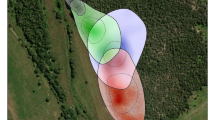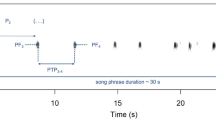Abstract
Some territorial animals exhibit a form of social recognition, commonly termed the "dear enemy effect", in which territory residents display lower levels of aggression toward familiar neighbors compared to unfamiliar individuals who are non-territorial "floaters". Despite the widespread occurrence of territorial social systems and use of acoustic signals for communication in anuran amphibians, only two previous studies have demonstrated vocally mediated dear enemy behavior in a territorial frog. In this study, I conducted neighbor-stranger discrimination playback experiments in a third species of territorial frog, the strawberry dart-poison frog, Dendrobates pumilio (Anura, Dendrobatidae). In the first experiment (n=24), I broadcast the calls of a subject's nearest neighbor and the calls of an unfamiliar individual from the approximate midpoint between the subject's and the neighbor's territories. Although males responded to the stimuli, they did not exhibit differential responses to the calls of neighbors and strangers. In a second experiment (n=22), I broadcast the calls of a neighbor and a stranger to subjects through a speaker located in the approximate center of the neighbor's territory. Males also responded to the playback, although less intensely than in the first experiment, but no discrimination between the calls of neighbors and strangers was found. Thus, territorial males of the strawberry dart-poison frog appear not to discriminate behaviorally between the advertisement calls of neighbors and strangers. Several proximate and ultimate-level hypotheses for this lack of vocally mediated neighbor-stranger discrimination are discussed.



Similar content being viewed by others
References
Baugh JR, Forester DC (1994) Prior residence effect in the dart-poison frog, Dendrobates pumilio. Behavior 131:207–224
Bee MA (2003) Experience-based plasticity of acoustically evoked aggression in a territorial frog. J Comp Physiol A 189:485–496
Bee MA, Gerhardt HC (2001a) Neighbour-stranger discrimination by territorial male bullfrogs (Rana catesbeiana). I. Acoustic basis. Anim Behav 62:1129–1140
Bee MA, Gerhardt HC (2001b) Neighbour-stranger discrimination by territorial male bullfrogs (Rana catesbeiana). II. Perceptual basis. Anim Behav 62:1141–1150
Bee MA, Gerhardt HC (2001c) Habituation as a mechanism of reduced aggression between neighbouring territorial male bullfrogs, Rana catesbeiana. J Comp Psychol 115:68–82
Bee MA, Gerhardt HC (2002) Individual voice recognition in a territorial frog (Rana catesbeiana). Proc R Soc Lond Ser B 269:1443–1448
Bee MA, Owen PC, Perrill SA (1999) Size assessment in simulated territorial encounters between male green frogs (Rana clamitans). Behav Ecol Sociobiol 45:177–184
Bee MA, Kozich CE, Blackwell KJ, Gerhardt HC (2001) Individual variation in advertisement calls of territorial male green frogs, Rana clamitans. Implications for individual discrimination. Ethology 107:65–84
Beecher MD (1990) The evolution of parent-offspring recognition in swallows. In: Dewsbury DA (ed) Contemporary issues in comparative psychology. Sinauer, Sunderland, pp 360–380
Beecher MD (1991) Success and failures of parent-offspring recognition in animals. In: Hepper PG (ed) Kin recognition. Cambridge University Press, Cambridge, pp 94–124
Bourne GR, Collins AC, Holder AM, McCarthy CL (2001) Vocal communication and reproductive behavior of the frog Colostethus beebei in Guyana. J Herpetol 35:272–281
Brenowitz EA, Rose GJ (1994) Behavioral plasticity mediates aggression in choruses of the Pacific treefrog. Anim Behav 47:633–641
Brenowitz EA, Rose GJ, Capranica RR (1985) Neural correlates of temperature coupling in the vocal communication system of the gray treefrog (Hyla versicolor). Brain Res 359:364–367
Bunnell P (1973) Vocalizations in the territorial behavior of the frog Dendrobates pumilio. Copeia 1973:277–284
Caldwell JP (1997) Pair bonding in spotted poison frogs. Nature 385:211
Cohen J (1988) Statistical power analysis for the behavioral science, 2nd edn. Erlbaum, Hillsdale, NJ
Colgan P (1983) Comparative social recognition. Wiley, New York
Davis MS (1987) Acoustically mediated neighbor recognition in the North American bullfrog, Rana catesbeiana. Behav Ecol Sociobiol 21:185–190
Donnelly MA (1989a) Effects of reproductive resource supplementation on space-use patterns in Dendrobates pumilio. Oecologia 81:212–218
Donnelly MA (1989b) Demographic effects of reproductive resource supplementation in a territorial frog, Dendrobates pumilio. Ecol Monogr 59:207–221
Donnelly MA (1991) Feeding patterns of the strawberry poison frog, Dendrobates pumilio, (Anura, Dendrobatidae). Copeia 1991:723–730
Duellman WE, Trueb L (1986) Biology of amphibians. John Hopkins University Press, Baltimore
Emlen ST (1976) Lek organization and mating strategies in the bullfrog, Rana catesbeiana. Behav Ecol Sociobiol 1:283–313
Forester DC, Cover J, Wisnieski A (1993) The influence of time of residency on the tenacity of territorial defense by the dart-poison frog Dendrobates pumilio. Herpetologica 49:94–99
Friedl TWP, Klump GM (2002) The vocal behaviour of male European treefrogs (Hyla arborea): implications for inter- and intrasexual selection. Behaviour 139:113–136
Gerhardt HC (1978) Temperature coupling in the vocal communication system of the gray treefrog, Hyla versicolor. Science 199:992–994
Gerhardt HC (1991) Female mate choice in treefrogs: static and dynamic acoustic criteria. Anim Behav 42:615–635
Gerhardt HC, Huber F (2002) Acoustic communication in insects and frogs. Chicago University Press, Chicago
Greenhouse SW, Geiser S (1959) On the methods in the analysis of profile data. Psychometrika 24:95–112
Howard RD (1978) The evolution of mating strategies in bullfrogs, Rana catesbeiana. Evolution 32:850–871
Howard RD, Young JR (1998) Individual variation in male vocal traits and female mating preferences in Bufo americanus. Anim Behav 55:1165–1179
Limerick S (1980) Courtship behavior and oviposition of the poison-arrow frog Dendrobates pumilio. Herpetologica 36:69–71
Marshall VT, Humfeld SC, Bee MA (2003) Mechanisms and evolution of plasticity of male aggressive signalling in spring peepers (Pseudacris crucifer). Anim Behav 65:1223–1234
Narins PM, Hödl W, Grabul DS (2003) Bimodal signal requirements for agonistic behavior in a dart-poison frog, Epipedobates femoralis. Proc Natl Acad Sci 100:577–580
Pröhl H (1997) Territorial behavior of the strawberry poison dart frog, Dendrobates pumilio. Amphib Reptil 18:437–442
Pröhl H (2002) Population differences in female resource abundance, adult sex ratio, and male mating success in Dendrobates pumilio. Behav Ecol 13:175–181
Pröhl H (2003) Variation in male calling behaviour and its influence on male mating success in the strawberry poison frog (Dendrobates pumilio). Ethology 109:273–290
Pröhl H, Berke O (2001) Spatial distribution of male and female strawberry poison frogs and their relation to female reproductive resources. Oecologia 129:534–542
Pröhl H, Hödl W (1999) Parental investment, potential reproductive rates, and mating system in the strawberry dart-poison frog, Dendrobates pumilio. Behav Ecol Sociobiol 46:215–220
Rosell FB, Bjørkøyli T (2002) A test of the dear enemy phenomenon in the Eurasian beaver. Anim Behav 63:1073–1078
Rosenthal R, Rosnow RL (1985) Contrast analysis: focused comparisons in the analysis of variance. Cambridge University Press, Cambridge
Rosenthal R, Rosnow RL (1991) Essentials of behavioral research: methods and data analysis. McGraw-Hill, New York
Schwartz JJ (1989) Graded aggressive calls of the spring peeper, Pseudacris crucifer. Herpetologica 45:172–181
Sherman PW, Reeve HK, Phennig DW (1997) Recognition systems. In: Krebs JR, Davies NB (eds) Behavioural ecology: an evolutionary approach, 4th edn. Blackwell, Boston
Simmons AM, Ferragamo M (1993) Periodicity extraction in the anuran auditory nerve. I. "Pitch-shift" effects. J Comp Physiol A 172:57–69
Simmons AM, Schwartz JJ, Ferragamo M (1992) Auditory nerve representation of a complex communication sound in background noise. J Acoust Soc Am 91:2831–2844
Simmons AM, Reese G, Ferragamo M (1993) Periodicity extraction in the anuran auditory nerve. II. Phase and temporal fine structure. J Acoust Soc Am 93:3374–3389
Simmons AM, Sanderson MI, Garabedian CE (2000) Representation of waveform periodicity in the auditory midbrain of the bullfrog, Rana catesbeiana. JARO 1:2–24
Stoddard PK (1996) Vocal recognition of neighbors by territorial passerines. In: Kroodsma DE, Miller EH (eds) Ecology and evolution of acoustic communication in birds. Cornell University Press, Ithaca, pp 356–374
Stoddard PK, Beecher MD, Horning CL, Willis MS (1990) Strong neighbor-stranger discrimination in song sparrows. Condor 92:1051–1056
Stoddard PK, Beecher MD, Horning CL, Campbell SE (1991) Recognition of individual neighbors by song in the song sparrow, a species with song repertoires. Behav Ecol Sociobiol 29:211–215
Summers K, Symula R, Clough M, Cronin T (1999) Visual mate choice in a frog. Proc R Soc Lond B 266:2141–2145
Temeles EJ (1994) The role of neighbours in territorial systems: when are they 'dear enemies'? Anim Behav 47:339–350
Wagner WE (1989) Graded aggressive signals in blanchard's cricket frog: vocal responses to opponent proximity and size. Anim Behav 38:1025–1038
Wells KD (1977) The social behaviour of anuran amphibians. Anim Behav 25:666–693
Weygoldt P (1980) Complex brood care and reproductive behavior in captive poison-arrow frogs, Dendrobates pumilio O. Schmidt. Behav Ecol Sociobiol 7:329–332
Ydenberg RC, Giraldeau LA, Falls JB (1988) Neighbours, strangers, and the asymmetric war of attrition. Anim Behav 36:343–347
Zimmermann E (1990) Behavioral signals and reproduction modes in the neotropical frog family Dendrobatidae. In: Hanke W (ed) Biology and physiology of amphibians. Fischer, Stuttgart, pp 61–73
Acknowledgements
I thank John Christy, Luis Mao, Carlos Dixon, and Enrike Downer for logistical support in Panama, Carl Gerhardt for equipment, and Sarah Humfeld, Vince Marshall, Stephanie Palmer, and Sandra Blumenrath for comments on earlier versions of the manuscript. The author was supported by a Doctoral Dissertation Improvement Grant from the National Science Foundation and a Short-term Fellowship from the Smithsonian Tropical Research Institute. The research in this study was approved by the University of Missouri IACUC (protocol no. 3479) and the Republic de Panama Instituto Nacional de Recursos Naturales Renovable (permit no. 26-200) and complies with all of the laws of the United States of America and Panama.
Author information
Authors and Affiliations
Corresponding author
Additional information
Communicated by T. Czeschlik
Rights and permissions
About this article
Cite this article
Bee, M.A. A test of the "dear enemy effect" in the strawberry dart-poison frog (Dendrobates pumilio). Behav Ecol Sociobiol 54, 601–610 (2003). https://doi.org/10.1007/s00265-003-0657-5
Received:
Revised:
Accepted:
Published:
Issue Date:
DOI: https://doi.org/10.1007/s00265-003-0657-5




